3 Summer Turf Diseases …and How to SOLVE THEM ALL!
July 5, 2018

Each season comes with its own set of stresses and challenges for turf grass. While it’s true that in general, more heat and moisture will increase the growth rate of common turf grasses, too much of either of these elements can add significant stress to turf. Extreme conditions sometimes foster an environment that encourages turf pathogens to take hold. Now that summer is in full swing, let’s look at three common summer turf diseases Brown Patch, Pythium Blight and Summer Patch. Spotting these diseases in the early stages will help you mitigate damage from these diseases before it becomes all encompassing.
BROWN PATCH
What to look for
Also known as “Rhizoctonia blight,” brown patch is caused by Rhizoctonia fungi. Brown patch becomes problematic during periods of high heat and humidity. It is most pervasive when low temperatures bottom out near 70F and day temperatures routinely exceed 85F. While warm season grasses are not immune, Brown Patch typically affects cool season grasses more severely.
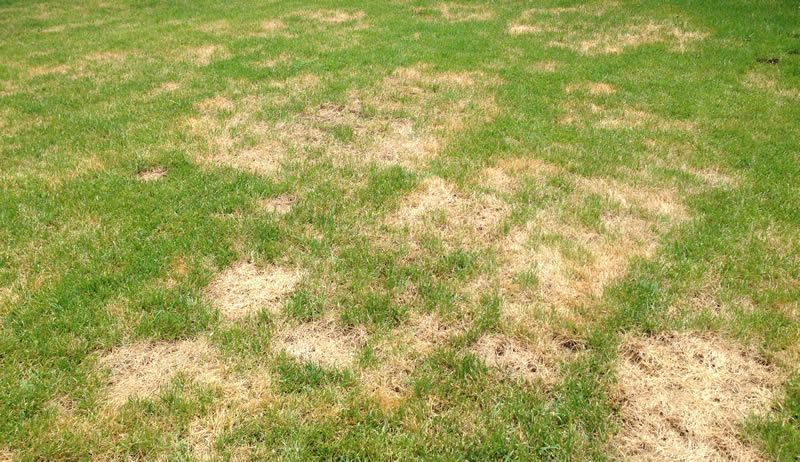
Rhizoctonia fungi pathogens begin by infecting the leaf blade. A brownish-purple band borders the lesions in the infected blade region. Sometimes turf can withstand blade infections, but should the fungus work its way into the crown (the actively growing region of the turf at ground level), most turf cannot survive. Brown patch starts as a small circle, then quickly expands in all directions, often leaving an affected patch more than 3 ft in diameter. A ‘smoke-ring’ with a blue or white appearance can often be seen on the leading edge of the patch as the fungal pathogen expands into healthy turf. ‘Cobweb-like’ structures can sometimes be seen when sunlight hits early morning dew in affected patches. These structures are the mycelium of the fungus; they are essentially filament-like extensions that help the fungus spread into new territory.

What to do
The rate of brown patch infection is completely dependent on various environmental factors. Unfortunately, a large patch can develop from perfectly healthy turf in under 24 hours, making this one of the more aggressive turf pathogens. Fungicides may be applied, however once the problem is spotted, most of the damage has probably already been done. In the event of an infection, curtail the use of nitrogen fertilizers. If possible, ensure the affected soil has adequate drainage. Once the patch has stopped expanding, begin the remediation process by sparingly using slow-release fertilizer (less than .25lbs/1000sqft). To accelerate recovery, adjust your mower height to a slightly higher setting and allow the turf to fill back in.
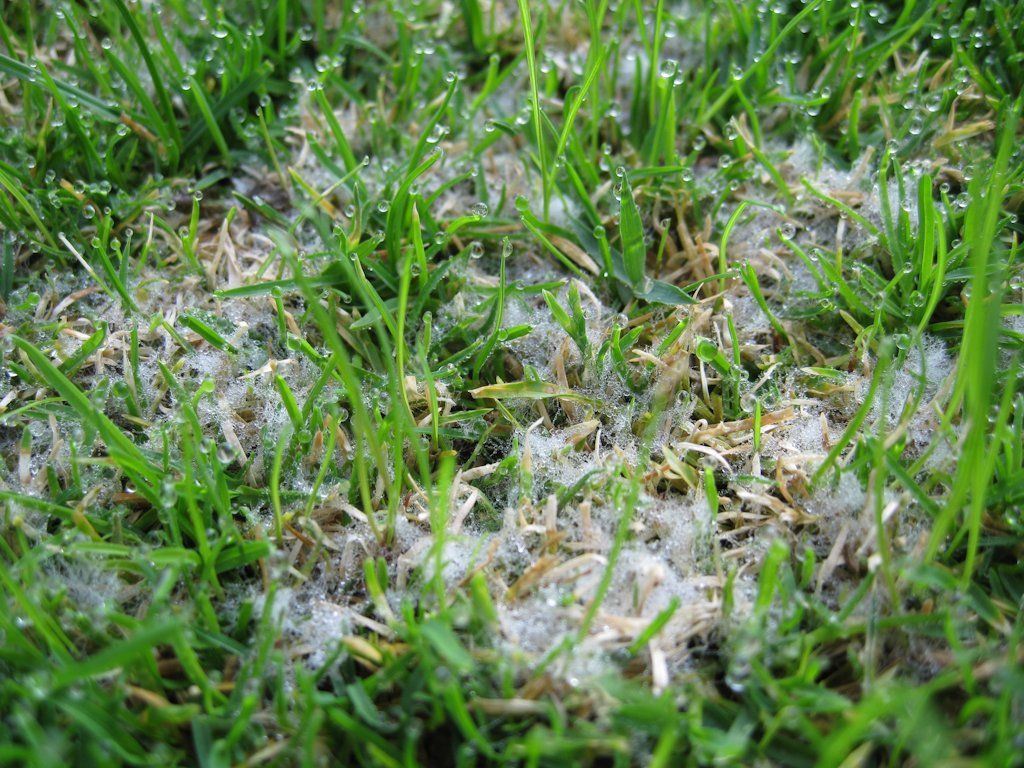
PYTHIUM BLIGHT
What to look for
Also known as “grease spot” or “cottony blight,” Pythium blight can be problematic for a variety of ryegrasses and bentgrasses. Pythium blight is typically identified as a smattering of irregularly shaped spots ranging from .5 to 4 inches in diameter. Affected areas turn brown quickly. Similar to that of Brown patch, the mycelium of the Pythium fungus can sometimes be seen on dew-soaked turf in the early morning. Pythium is an extremely hardy fungus, often overwintering in spore form inside grass clipping and other biodegrading plant material in the thatch layer. When temperatures exceed 85F, Pythium is particularly destructive.
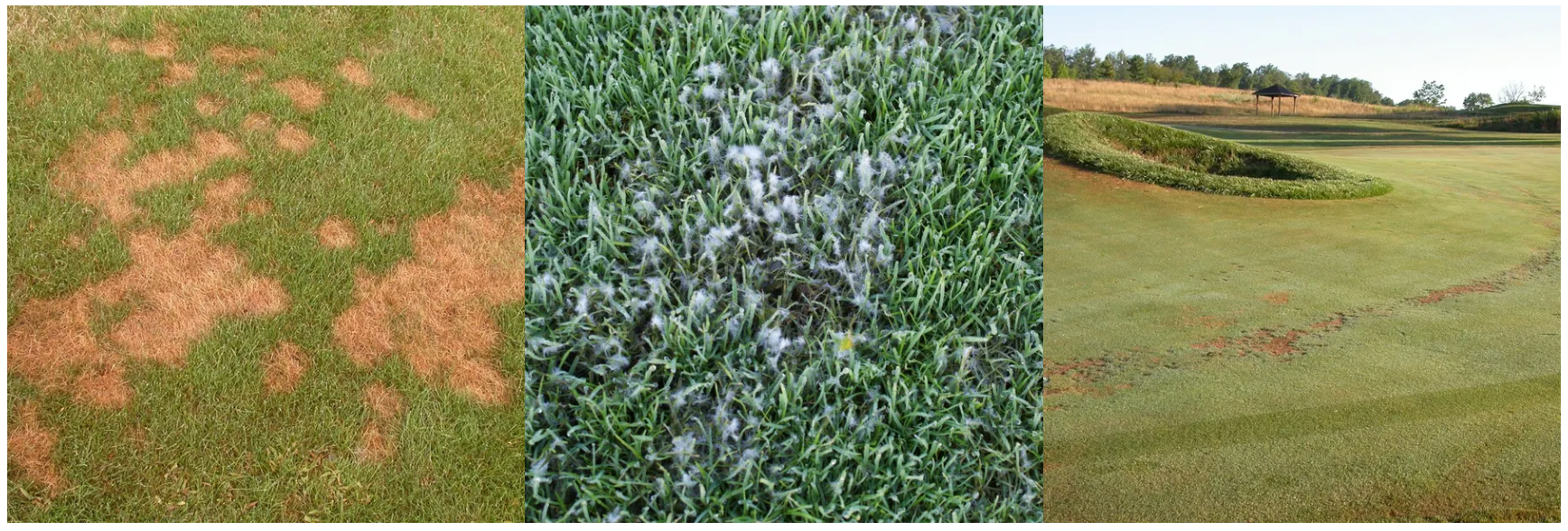
What to do
Once identified, first cease the use of all fertilizers. The application of a fungicide is highly recommended the moment this fungus becomes problematic. On turf that has a history of Pythium blight, preventative fungicide applications are recommended. Ensure that the turf has adequate drainage. Once the disease appears to have halted its expansion, begin applying low doses of slow release fertilizer. Do not water lawns in the evening or at night. To prevent Pythium outbreaks in subsequent years, consider proper dethatching and aeration techniques in early fall and early spring (before rapid turf growth).
SUMMER PATCH
What to look for
Caused by the fungal pathogen Magnaporthe poae, summer patch (sometimes called ‘Poa patch’) primarily affects Kentucky bluegrass and other smaller fescues. It is particularly aggressive in high-maintenance lawns such as fairways. Summer patch is most commonly observed in areas of high foot traffic, poor drainage, and thatch build-up. The fungal pathogen begins by infecting root systems early in the spring, long before symptoms become visible. Eventually, stressed root systems under high soil temperatures (65F+) succumb to rapid pathogen expansion across the plant. Small circular patches appear in clusters overnight. Within a day or two, patches can expand to more than 12 inches in diameter.
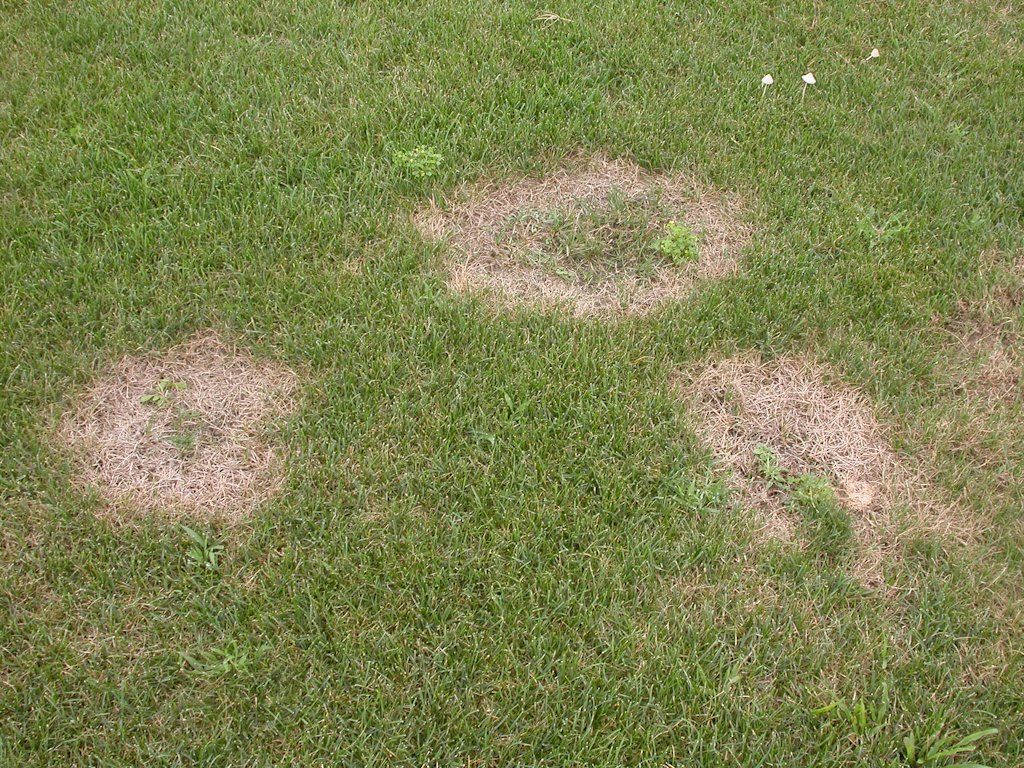
What to do
In the event of a summer patch outbreak, penetrant fungicides are recommended because they are better able to move into the root zone (the primary area of infection), however they are rather expensive, and only recommended in the event of a severe outbreak. The fungicide will be most effective when the pathogen is most active, therefore it is recommended that soil temperatures achieve a maximum of 65F+ for 3 consecutive days before application.
There are many preventive measures that may be employed to reduce the chances of an outbreak. Core aeration/deep tine aeration in the fall and spring assist turf rooting by breaking up the thatch layer and increasing air exchange with the soil. Prolonged, but infrequent irrigation helps to prevent the kind of environmental conditions that encourage the Magnaporthe poae pathogen from establishing. Ensure that turf has an adequate supply nitrogen to reduce plant stress (always follow the recommended application rate of any fertilizer based on the climate and grass species). In the hot summer months, it is recommended that bluegrass and other smaller fescues receive no more than 0.1-0.2 lbs N per 1000sqft. Cutting the turf height to 2.5-3 inches will also reduce turf stress, making it less susceptible to fungal pathogens. Once the pathogen has run its course, new bluegrass blades may begin to fill in from the center outward, however in the more severe cases, topdressing and reseeding may be necessary.
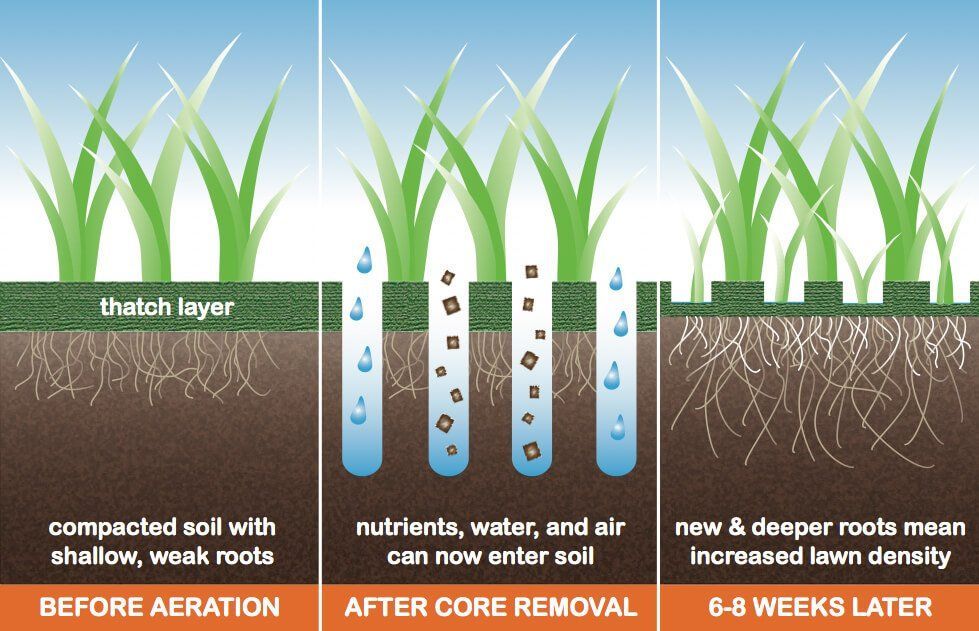
FINAL THOUGHTS Turf diseases caused by fungal pathogens are very difficult to prevent outright because they spread very quickly. Good lawn maintenance practices in conjunction with knowing what symptoms to look for can mean the difference between having to remediate a few small affected patches of turf OR having a full-blown fungal outbreak across your yard. Keep your lawn green and health this summer; when the weather turns hot and humid, stay vigilant!
For professional fertilizers, humic and AMP-XC™ enriched products available, please visit TurfCare’s online Product Catalog.
For green industry professionals or others interested in ordering Turfcare products, please contact our Customer Service to find a distributor near you.
Resources:
https://plantscience.psu.edu/research/centers/turf/extension/factsheets/managing-diseases/pythium
https://siteone.com/home/resources-services/technical-support/pythium-blight.aspx
https://www.lawn-care-academy.com/lawn-diseases.html
https://www.trugreen.com/blog/lawn-disease/what-is-brown-patch-lawn-disease
https://plantscience.psu.edu/research/centers/turf/extension/factsheets/managing-diseases/summer-patch
http://ipm.ucanr.edu/PMG/r785100611.html
http://www.msuturfdiseases.net/details/_/summer_patch_18/
Pictures:
http://www.centralsodil.com/media/wysiwyg/brown_patch.jpg (Brown patch 01)
http://www.msuturfdiseases.net/images/galleries/brown-patch/1.jpg(Brown patch 02)
https://i.pinimg.com/736x/e2/b1/bf/e2b1bfd012f17da4017155f47f79e0dc.jpg(Brown patch 03)
http://www.turfdiseases.org/turfdisewp/wp-content/uploads/2011/07/Dollar-spot-81.jpg(Brown patch 04)
http://www.turfdiseases.org/turfdisewp/wp-content/uploads/2011/07/Pythium-blight-51.jpg (Pythium blight 01)
http://2.bp.blogspot.com/_sy6qQG9pOaw/TFrqTk6DLwI/AAAAAAAAA8M/HNgfEKz-eGA/s1600/Pythium+2.JPG(Pythium blight 02)
http://www.turfdiseases.org/turfdisewp/wp-content/uploads/2011/07/Pythium-blight-21.jpg(Pythium blight 03)
https://upload.wikimedia.org/wikipedia/commons/thumb/f/f8/Pythium_%28257_23%29.jpg/1200px-Pythium_%28257_23%29.jpg(Pythium blight – fungi – 04)
http://www.turfdiseases.org/turfdisewp/wp-content/uploads/2011/07/summer-patch-31.jpg
http://simplygreenlawncare.com/wp-content/uploads/2013/03/core.jpg
http://www.turfdiseases.org/turfdisewp/wp-content/uploads/2011/07/summer-patch-21.jpg
The TURFReport Highlights:
Additional Articles and Insights

April 18, 2025
Turf Care Supply, LLC, a portfolio company of Platte River Equity, has officially acquired Beaty Fertilizer, the industry respected Tennessee-based manufacturer and blender of custom granular and liquid fertilizers, as well as combination products. This strategic move expands Turf Care’s manufacturing footprint, adds new product capabilities, and enhances overall production capacity.

October 4, 2024
Dear Valued Industry Partners and Customers, We are pleased to announce that Turf Care Supply, LLC has acquired Agri-Nutrients, Inc. (October 1, 2024) a respected manufacturer in the turf and ornamental fertilizer industry. This acquisition marks a significant step forward in our commitment to providing you with an expanded range of innovative products, services, and industry expertise, all designed to support your business’s continued growth and success. As a valued partner or customer, you will benefit from enhanced service capabilities and an extended geographic reach, thanks to Agri-Nutrients, Inc.’s strategic facility located in the Port of Catoosa, Oklahoma. With this established presence in the Southwest and Western markets, Turf Care Supply, LLC’s expanded operational footprint will allow us to serve a broader region with greater efficiency, delivering even stronger support to help drive your business forward. We are dedicated to ensuring a seamless transition while maintaining the high standards of service you expect. If you have any questions or would like to explore how this new location can enhance your operations, please feel free to contact your account manager or our customer service team. Thank you for your continued trust in Turf Care Supply, LLC . We look forward to partnering with you as we grow together and continue supporting your success. Sincerely, Mark ManganPresidentTurf Care Supply, LLC

September 28, 2023
With a focus on providing sustainable manufacturing and reducing carbon emissions, Turf Care Supply has embraced the electric power market with the latest mobile equipment upgrades. Completed in June 2023, TCS received all deliveries of electric forklifts to all three manufacturing facilities, including Hatfield, MA, Martins Ferry, OH and Sebring, FL.

July 19, 2023
When handling fertilizers and pesticide it is important to follow suggested guidelines and prioritize safety to protect yourself, others, and reduce environmental impact. Here are some general measures to follow: 1.Read and Follow Instructions: Carefully read and understand the product labels, safety data sheets (SDS), and any accompanying instructions provided by the manufacturer. Follow all recommended guidelines, precautions, and application rates.

June 22, 2023
It’s common knowledge that applying too much fertilizer containing high percentages of readily available nitrogen and water soluble nutrients can result in burn damage to plants, but did you know that damage can still occur even if your application rate is correct? Applying the right product at the right rate, but at the WRONG time can have disastrous consequences.

August 1, 2022
When summer temperatures rise and drought conditions set in, turf quality can suffer, even in healthy turf. Turf that was green and lush during the spring can be at risk for turning brown and going dormant during the summer months. This can lead to insect and weed infestations as well as other diseases that can result in additional turf damage. Being aware of these abiotic stresses can help lawn care operators, turf managers, and homeowners take steps to mitigate the damage from these stressors.

July 28, 2022
Brunswick, OH. (April 25, 2022) – Turf Care Supply, LLC (“Turf Care” or the “Company”), the leading formulator and blender of coated nitrogen and other fertilizer products to the turf & ornamental market, is excited to announce Michael Randall as the new Chief Financial Officer (CFO). Mike Randall has previously served as the CFO for both Anchor Manufacturing and for a private investment group, The Misfud Group, LLC. Mike has also held a variety of financial positions with Shiloh Industries in Valley City, Ohio and Eaton Corporation in Cleveland. Mike received his Accounting degree from Ohio Wesleyan University. “We are very excited to have Mike join the Turf Care team. Mike’s frontline leadership and successful C level experience make him an incredible addition to our company,” said Mark Mangan, President of Turf Care. Established in 1974, Turf Care Supply is one of the largest formulators and blenders of urea products to the turf & ornamental market. Turf Care has a comprehensive product portfolio of fertilizers, combination products (herbicide/insecticide), soil amendments and enhanced efficiency fertilizer ingredients. Turf Care's products are sold to distributors and blenders serving the commercial, residential and golf end markets.

April 18, 2025
Turf Care Supply, LLC, a portfolio company of Platte River Equity, has officially acquired Beaty Fertilizer, the industry respected Tennessee-based manufacturer and blender of custom granular and liquid fertilizers, as well as combination products. This strategic move expands Turf Care’s manufacturing footprint, adds new product capabilities, and enhances overall production capacity.

October 4, 2024
Dear Valued Industry Partners and Customers, We are pleased to announce that Turf Care Supply, LLC has acquired Agri-Nutrients, Inc. (October 1, 2024) a respected manufacturer in the turf and ornamental fertilizer industry. This acquisition marks a significant step forward in our commitment to providing you with an expanded range of innovative products, services, and industry expertise, all designed to support your business’s continued growth and success. As a valued partner or customer, you will benefit from enhanced service capabilities and an extended geographic reach, thanks to Agri-Nutrients, Inc.’s strategic facility located in the Port of Catoosa, Oklahoma. With this established presence in the Southwest and Western markets, Turf Care Supply, LLC’s expanded operational footprint will allow us to serve a broader region with greater efficiency, delivering even stronger support to help drive your business forward. We are dedicated to ensuring a seamless transition while maintaining the high standards of service you expect. If you have any questions or would like to explore how this new location can enhance your operations, please feel free to contact your account manager or our customer service team. Thank you for your continued trust in Turf Care Supply, LLC . We look forward to partnering with you as we grow together and continue supporting your success. Sincerely, Mark ManganPresidentTurf Care Supply, LLC

September 28, 2023
With a focus on providing sustainable manufacturing and reducing carbon emissions, Turf Care Supply has embraced the electric power market with the latest mobile equipment upgrades. Completed in June 2023, TCS received all deliveries of electric forklifts to all three manufacturing facilities, including Hatfield, MA, Martins Ferry, OH and Sebring, FL.

July 19, 2023
When handling fertilizers and pesticide it is important to follow suggested guidelines and prioritize safety to protect yourself, others, and reduce environmental impact. Here are some general measures to follow: 1.Read and Follow Instructions: Carefully read and understand the product labels, safety data sheets (SDS), and any accompanying instructions provided by the manufacturer. Follow all recommended guidelines, precautions, and application rates.

June 22, 2023
It’s common knowledge that applying too much fertilizer containing high percentages of readily available nitrogen and water soluble nutrients can result in burn damage to plants, but did you know that damage can still occur even if your application rate is correct? Applying the right product at the right rate, but at the WRONG time can have disastrous consequences.

August 1, 2022
When summer temperatures rise and drought conditions set in, turf quality can suffer, even in healthy turf. Turf that was green and lush during the spring can be at risk for turning brown and going dormant during the summer months. This can lead to insect and weed infestations as well as other diseases that can result in additional turf damage. Being aware of these abiotic stresses can help lawn care operators, turf managers, and homeowners take steps to mitigate the damage from these stressors.



